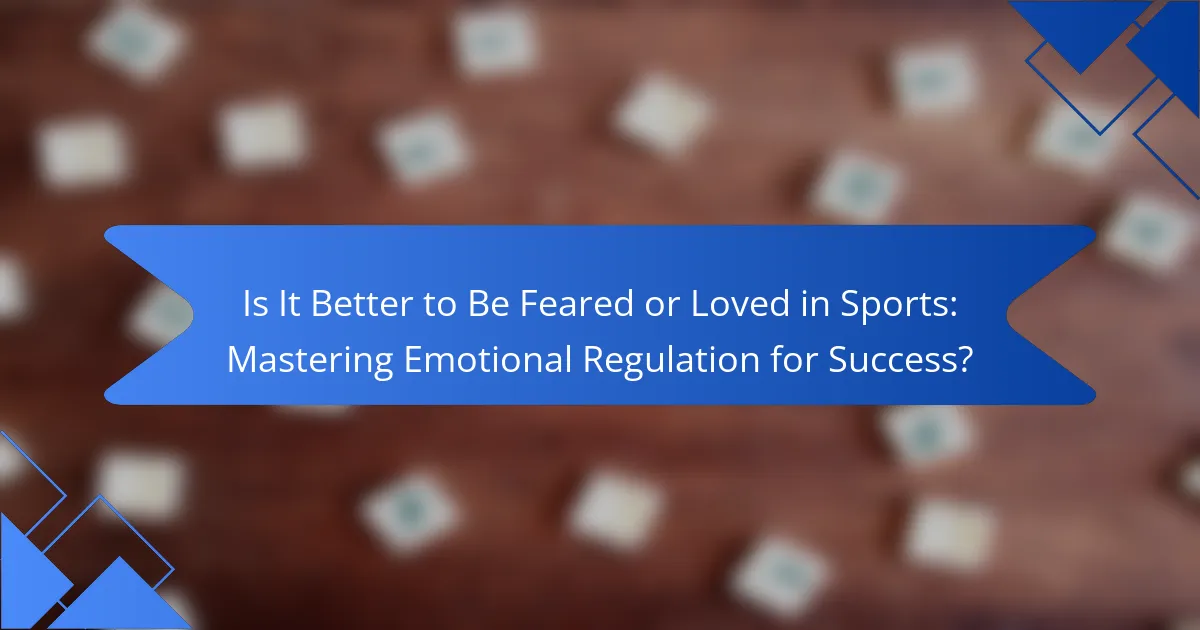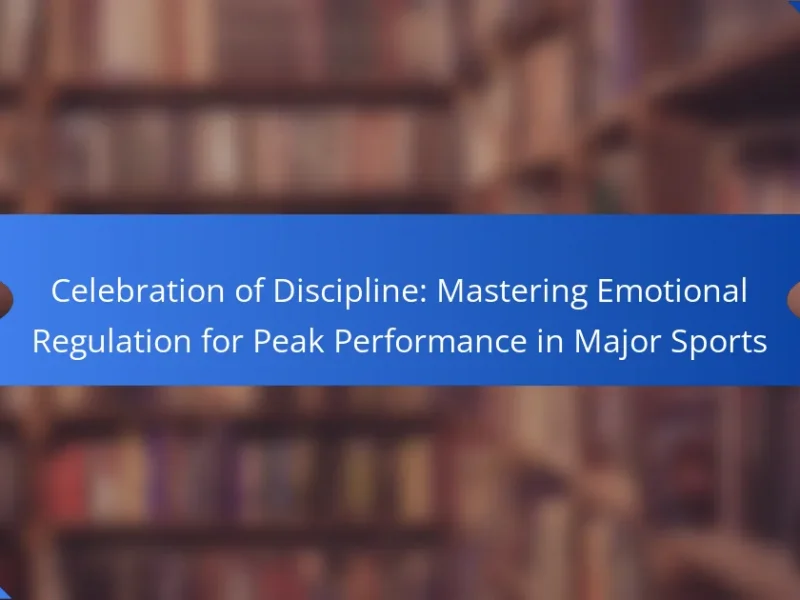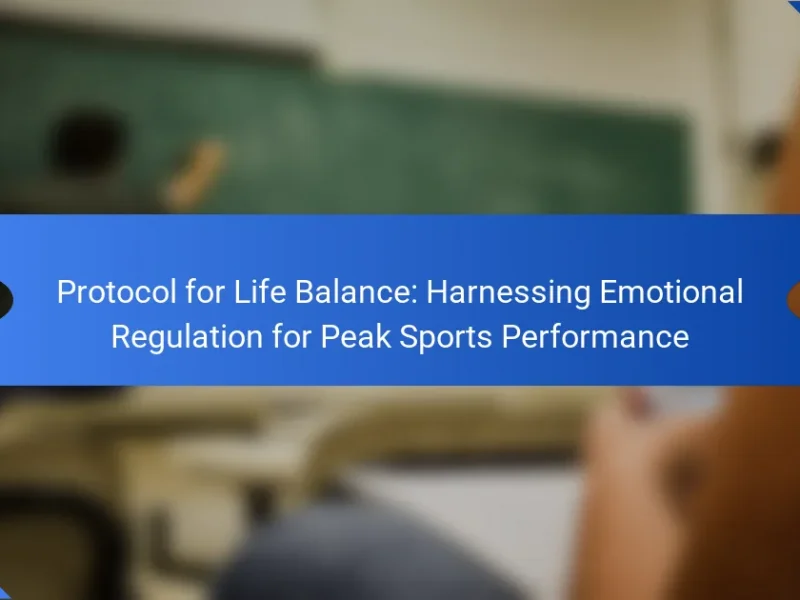Emotional regulation is essential for success in sports, impacting performance and decision-making. This article explores the balance between being feared and loved, the key attributes of emotional regulation, and effective strategies for managing emotions. It examines how regional perceptions influence athletes’ emotional strategies and highlights best practices for enhancing mental resilience. Understanding these elements can significantly improve an athlete’s performance and overall success in competitive environments.

What is the Role of Emotional Regulation in Sports?
Emotional regulation is crucial for success in sports, as it influences performance and decision-making. Athletes who master emotional regulation can maintain composure under pressure, enhancing focus and resilience. Research shows that effective emotional management leads to improved performance metrics, such as reaction times and accuracy. Moreover, athletes who balance being feared and loved often find greater team cohesion and support, fostering a positive competitive environment. This balance is a unique attribute that can differentiate successful athletes from their peers.
How Do Athletes Define Being Feared vs. Loved?
Athletes often view being feared as a means to command respect and dominance, while being loved fosters camaraderie and support. Mastering emotional regulation can help athletes balance these dynamics for success. Fear can lead to intimidation, potentially enhancing performance through pressure. Conversely, love cultivates teamwork and collaboration, essential for long-term success. Athletes who can transition between these emotional states may find they can leverage both fear and love to optimize their performance in sports.
What Psychological Theories Support Emotional Regulation in Sports?
Psychological theories such as the Cognitive Behavioral Theory and Self-Determination Theory support emotional regulation in sports. These frameworks emphasize the importance of managing emotions for optimal performance. Cognitive Behavioral Theory focuses on identifying and altering negative thought patterns, which can enhance athletes’ emotional responses. Self-Determination Theory highlights intrinsic motivation, which fosters emotional resilience. Research shows that athletes who effectively regulate their emotions experience improved focus, reduced anxiety, and better overall performance. Emotional regulation strategies, including mindfulness and visualization, further strengthen these psychological foundations, enabling athletes to thrive under pressure.

What Are the Universal Attributes of Emotional Regulation Systems?
Emotional regulation systems universally share attributes that enhance performance in sports. Key attributes include awareness of emotions, ability to manage stress, and adaptability to changing situations. These attributes help athletes decide whether to cultivate fear or love in their interactions.
Awareness of emotions allows athletes to recognize their feelings and triggers, leading to better decision-making. Managing stress is crucial, as it directly impacts performance under pressure. Adaptability enables athletes to adjust their emotional responses based on the context, optimizing their interactions with teammates and opponents.
In conclusion, mastering these universal attributes of emotional regulation is essential for success in sports, influencing how athletes choose to be perceived by others.
How Does Emotional Regulation Impact Performance Consistency?
Emotional regulation significantly enhances performance consistency in sports. Athletes who master their emotions can maintain focus, manage stress, and make better decisions during competition. Research shows that emotional stability contributes to improved concentration and resilience, leading to more reliable performance outcomes. For instance, athletes with high emotional intelligence tend to adapt better to pressure, resulting in fewer performance fluctuations. This mastery of emotional regulation can be a unique attribute that distinguishes successful athletes from their peers.
What Are Common Emotional Regulation Techniques Used by Athletes?
Athletes commonly use techniques such as mindfulness, visualization, and self-talk to regulate emotions effectively. Mindfulness helps athletes stay present, reducing anxiety. Visualization allows them to mentally rehearse performance, enhancing confidence. Self-talk fosters a positive mindset, promoting resilience during competition.

What Unique Attributes Distinguish Emotional Regulation Strategies?
Emotional regulation strategies are distinguished by their unique attributes, such as adaptability, focus, and resilience. These attributes enable athletes to manage their emotions effectively, influencing performance outcomes. For instance, adaptability allows athletes to adjust their emotional responses based on situational demands, enhancing their ability to cope with stress. Focus helps in maintaining concentration during competitions, while resilience fosters recovery from setbacks. These unique attributes collectively contribute to mastering emotional regulation, ultimately impacting success in sports.
How Do Different Sports Cultures Influence Emotional Regulation?
Different sports cultures shape emotional regulation strategies, affecting athletes’ performance. Cultures that emphasize teamwork foster emotional resilience, while those prioritizing individual achievement may lead to heightened stress. For example, collectivist cultures encourage shared emotional experiences, enhancing group cohesion and support. In contrast, competitive environments can create fear-driven motivation, impacting mental health. Understanding these cultural influences is crucial for mastering emotional regulation in sports, ultimately leading to success.
What Role Does Coaching Style Play in Emotional Regulation?
Coaching style significantly influences emotional regulation in sports. A supportive coaching approach fosters trust, enhancing athletes’ emotional stability. In contrast, a fear-based style may induce anxiety, undermining performance. Research indicates that athletes thrive under coaches who prioritize emotional intelligence, leading to improved focus and resilience.

What Rare Attributes Are Associated with Emotional Regulation Success?
Emotional regulation success is often linked to rare attributes such as resilience, adaptability, and self-awareness. These qualities enable athletes to manage stress and maintain focus under pressure. Resilience helps individuals bounce back from setbacks, while adaptability allows for quick adjustments in strategy. Self-awareness fosters better understanding of emotional triggers, enhancing decision-making. Together, these attributes contribute significantly to mastering emotional regulation in sports.
How Can Emotional Regulation Lead to Unprecedented Athletic Achievements?
Emotional regulation significantly enhances athletic performance by fostering focus and resilience. Athletes who master their emotions can maintain composure under pressure, leading to improved decision-making and execution. This ability to manage feelings directly correlates with unprecedented achievements in sports. For instance, studies indicate that athletes with strong emotional regulation skills often outperform their peers in high-stress situations. Consequently, the balance between being feared and loved can hinge on an athlete’s emotional control, as it influences team dynamics and personal motivation.
What Examples Exist of Athletes Mastering Emotional Regulation?
Athletes mastering emotional regulation often exhibit resilience and control in high-pressure situations. Examples include Michael Jordan, who utilized visualization techniques to enhance focus, and Serena Williams, who practices mindfulness to maintain composure during matches. These strategies enable them to channel emotions positively, improving performance. Additionally, Tom Brady emphasizes emotional stability, using routines to prepare mentally for games. Such mastery of emotional regulation leads to consistent success in sports.

How Do Regional Perceptions Affect Emotional Regulation in Sports?
Regional perceptions significantly influence emotional regulation in sports, often determining whether athletes are feared or loved. Athletes from cultures that prioritize aggression may thrive under fear, enhancing performance through heightened adrenaline. Conversely, those in supportive environments may excel when loved, benefiting from positive reinforcement. Understanding these dynamics helps athletes tailor their emotional strategies for success, adapting to regional expectations. This adaptability can lead to improved performance and resilience, highlighting the importance of emotional regulation in diverse sporting contexts.
What Are the Regional Variations in Emotional Regulation Practices?
Emotional regulation practices in sports vary significantly by region, influenced by cultural attitudes. In North America, a focus on individualism promotes self-expression, while East Asian cultures emphasize emotional restraint and harmony. Latin American sports often celebrate passion and intensity, encouraging athletes to express emotions openly. These regional differences shape how athletes manage fear and love, impacting their performance and relationships in sports. Understanding these variations is essential for coaches and athletes aiming for success.

What Best Practices Can Athletes Implement for Effective Emotional Regulation?
Athletes can implement several best practices for effective emotional regulation, enhancing their performance and mental resilience. Techniques include mindfulness meditation, which fosters self-awareness and reduces anxiety. Cognitive restructuring helps athletes reframe negative thoughts, promoting a positive mindset. Regular physical activity not only improves physical fitness but also releases endorphins, enhancing mood. Additionally, developing strong support networks provides emotional stability, allowing athletes to share experiences and cope with stress. Finally, setting realistic goals can prevent feelings of overwhelm, ensuring athletes maintain focus and motivation.
What Common Mistakes Should Athletes Avoid in Emotional Regulation?
Athletes should avoid common mistakes in emotional regulation to enhance performance. Key pitfalls include ignoring emotions, overreacting to stress, and failing to seek support. Recognizing and managing emotions is vital for maintaining focus and resilience. Additionally, athletes should not equate fear with respect; fostering positive relationships can improve team dynamics and overall success.
How Can Athletes Optimize Their Emotional Regulation Techniques?
Athletes can optimize emotional regulation techniques by focusing on mindfulness, cognitive restructuring, and physiological awareness. Mindfulness enhances present-moment awareness, reducing anxiety and improving focus. Cognitive restructuring involves reframing negative thoughts into positive perspectives, fostering resilience. Physiological awareness helps athletes recognize bodily signals of stress, allowing proactive management. Implementing these techniques consistently can lead to improved performance and emotional stability in high-pressure situations.
What Expert Insights Can Guide Athletes in Mastering Emotional Regulation?
Emotional regulation is crucial for athletes’ success, balancing fear and love influences performance. Expert insights emphasize self-awareness, mindfulness, and emotional intelligence as key strategies. These skills enhance decision-making under pressure, fostering resilience. Regular practice of techniques, such as visualization and breathing exercises, equips athletes to manage stress effectively. Additionally, cultivating a supportive environment encourages open communication, allowing athletes to express emotions constructively. This holistic approach not only improves individual performance but also strengthens team dynamics, leading to overall success in sports.


